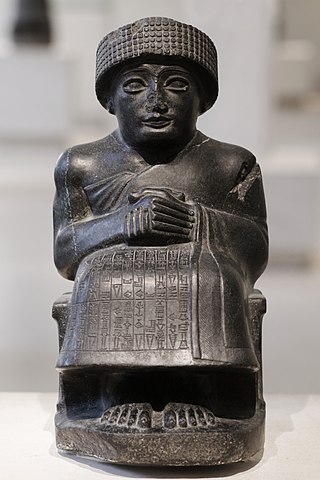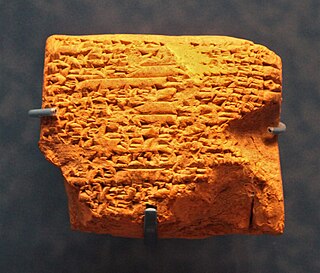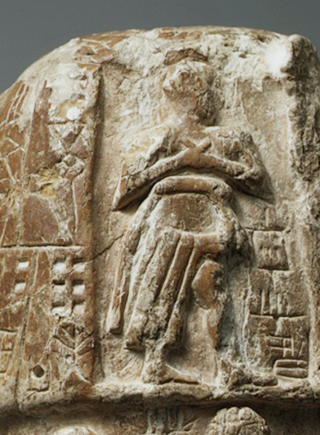La-ba'shum of Uruk was the eighth Sumerian ruler in the First Dynasty of Uruk (ca. 26th century BC), according to the Sumerian King List .
La-ba'shum of Uruk was the eighth Sumerian ruler in the First Dynasty of Uruk (ca. 26th century BC), according to the Sumerian King List .

Sumer is the earliest known civilization, located in the historical region of southern Mesopotamia, emerging during the Chalcolithic and early Bronze Ages between the sixth and fifth millennium BC. Like nearby Elam, it is one of the cradles of civilization, along with Egypt, the Indus Valley, the Erligang culture of the Yellow River valley, Caral-Supe, and Mesoamerica. Living along the valleys of the Tigris and Euphrates rivers, Sumerian farmers grew an abundance of grain and other crops, a surplus which enabled them to form urban settlements. The world's earliest known texts come from the Sumerian cities of Uruk and Jemdet Nasr, and date to between c. 3350 – c. 2500 BC, following a period of proto-writing c. 4000 – c. 2500 BC.

The Sumerian King List or Chronicle of the One Monarchy is an ancient literary composition written in Sumerian that was likely created and redacted to legitimize the claims to power of various city-states and kingdoms in southern Mesopotamia during the late third and early second millennium BC. It does so by repetitively listing Sumerian cities, the kings that ruled there, and the lengths of their reigns. Especially in the early part of the list, these reigns often span thousands of years. In the oldest known version, dated to the Ur III period but probably based on Akkadian source material, the SKL reflected a more linear transition of power from Kish, the first city to receive kingship, to Akkad. In later versions from the Old Babylonian period, the list consisted of a large number of cities between which kingship was transferred, reflecting a more cyclical view of how kingship came to a city, only to be inevitably replaced by the next. In its best-known and best-preserved version, as recorded on the Weld-Blundell Prism, the SKL begins with a number of antediluvian kings, who ruled before a flood swept over the land, after which kingship went to Kish. It ends with a dynasty from Isin, which is well-known from other contemporary sources.

The history of Sumer spans the 5th to 3rd millennia BCE in southern Mesopotamia, and is taken to include the prehistoric Ubaid and Uruk periods. Sumer was the region's earliest known civilization and ended with the downfall of the Third Dynasty of Ur around 2004 BCE. It was followed by a transitional period of Amorite states before the rise of Babylonia in the 18th century BCE.
Uruk, today known as Warka, was a city in the ancient Near East situated east of the present bed of the Euphrates River on the dried-up ancient channel of the Euphrates. The site lies 93 kilometers northwest of ancient Ur, 108 kilometers southeast of ancient Nippur, and 24 kilometers southeast of ancient Larsa. It is 30 km (19 mi) east of modern Samawah, Al-Muthannā, Iraq.

Lugal-Zage-Si of Umma was the last Sumerian king before the conquest of Sumer by Sargon of Akkad and the rise of the Akkadian Empire, and was considered as the only king of the third dynasty of Uruk, according to the Sumerian King List. Initially, as king of Umma, he led the final victory of Umma in the generation-long conflict with the city-state Lagash for the fertile plain of Gu-Edin. Following up on this success, he then united Sumer briefly as a single kingdom.

Lugalbanda was a deified Sumerian king of Uruk who, according to various sources of Mesopotamian literature, was the father of Gilgamesh. Early sources mention his consort Ninsun and his heroic deeds in an expedition to Aratta by King Enmerkar.

Aratta is a land that appears in Sumerian myths surrounding Enmerkar and Lugalbanda, two early and possibly mythical kings of Uruk also mentioned on the Sumerian king list.

Enmerkar was an ancient Sumerian ruler to whom the construction of the city of Uruk and a 420-year reign was attributed. According to literary sources, he led various campaigns against the land of Aratta.

Utu-hengal, also written Utu-heg̃al, Utu-heĝal, and sometimes transcribed as Utu-hegal, Utu-hejal, Utu-Khengal, was one of the first native kings of Sumer after two hundred years of Akkadian and Gutian rule, and was at the origin of the foundation of the Third Dynasty of Ur by his son-in-law Ur-Nammu. He was officially "King of Uruk" in his inscriptions, and is therefore considered as the founder, and only member, of the "Fifth dynasty of Uruk".

Enmerkar and the Lord of Aratta is a legendary Sumerian account, preserved in early post-Sumerian copies, composed in the Neo-Sumerian period . It is one of a series of accounts describing the conflicts between Enmerkar, king of Unug-Kulaba, and the unnamed king of Aratta.

Dumuzid, titled the Fisherman, was a legendary Sumerian king of Uruk listed originating from Kuara. According to legend, in the one-hundredth year of his reign, he was captured by Enmebaragesi.

Aga commonly known as Aga of Kish, was the twenty-third and last king in the first dynasty of Kish during the Early Dynastic I period. He is listed in the Sumerian King List and many sources as the son of Enmebaragesi. The Kishite king ruled the city at its peak, probably reaching beyond the territory of Kish, including Umma and Zabala.
Ur-Nungal of Uruk was the sixth Sumerian ruler in the First Dynasty of Uruk, according to the Sumerian King List, which also claims he ruled 30 years. Both the Sumerian King List and the Tummal Chronicle state he was the son of Gilgamesh, but only the Sumerian King List records he was the father of Udul-kalama.
Udul-kalama of Uruk was the seventh Sumerian ruler in the First Dynasty of Uruk, according to the Sumerian King List. He was a son of Ur-Nungal and grandson of Gilgamesh. However, unlike his predecessors, he left no other known documents or relics mentioning his name, and he may have been one of several minor kings of Uruk added to the list, who reigned when hegemony was actually held by the first dynasty of Ur.

E-anna, also referred to as the Temple of Inanna, was an ancient Sumerian temple in Uruk. Considered the "residence" of Inanna, it is mentioned throughout the Epic of Gilgamesh and various other texts. The evolution of the gods to whom the temple was dedicated is the subject of scholarly study.
En-nun-tarah-ana of Uruk was the ninth Sumerian ruler in the First Dynasty of Uruk According to the Sumerian King List, he reigned for 8 years.
Lugal-kitun was the 12th and last lugal of the first Dynasty of Uruk. He ruled in Mesopotamia in modern-day Iraq. Little is known about Lugal-kitun.

Lugal-kisalsi, also Lugaltarsi was a King of Uruk and Ur who lived towards the end of the 25th century BCE, succeeding his father Lugal-kinishe-dudu, according to contemporary inscriptions, although he does not appear in the Sumerian King List. In one of his inscriptions, he appears as "Lugalkisalsi, the first-born son of Lugalkigenedudu, king of Uruk and Ur".
Ur-nigin, also Ur-nigina or Ur-nigar was a Governor (ensi) of Uruk who lived in 22nd century BCE.
Ur-gigir was the son of Ur-nigin and a Governor (ensi) of Uruk who lived in 22nd century BCE.